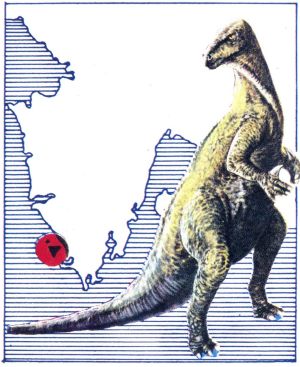Croatia 1994 "The Coastal Dinosaur Finds In West Istria"
| <prev | back to index | next> |
| Issue Date | 07.03.1994 |
| ID | Michel: 268-269, Scott: 185a-186b, Stanley Gibbons: 267-268, Yvert et Tellier: 224-225, Category: pR |
| Design | Dr. Toni Nikolic biologist from Zagreb |
| Stamps in set | 2 |
| Value | 4000 HRD - reconstruction and skeleton of Iguanodon with map of Istria 2400 HRD - reconstruction of Iguanodon |
| Emission/Type | commemorative |
| Places of issue | Zagreb |
| Size (width x height) | 29,8mm x 35,5mm |
| Layout | Sheet of 20 stamps (4x5): 2 stripes of 2 es-tenant stamps per row |
| Products | FDC x1 |
| Paper | white 90g, gummed |
| Perforation | 14 |
| Print Technique | Offset, multicolor |
| Printed by | "Zrinski" - Cakovec |
| Quantity | 400.000 sets |
| Issuing Authority | The Croatian Post and Telecommunications |
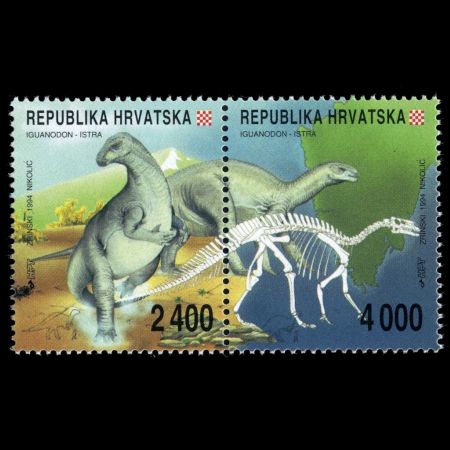
On March 7th 1994, Croatian Post and Telecommunications issued the set of two se-tenant stamps "The Coastal Dinosaur Finds In West Istria" depicting a reconstruction and a skeleton of the dinosaur Iguanodon.
The place where these fossils were found is shown on the cachet of the FDC. These stamps were issued to commemorate the start of international multidisciplinary research (Croatian-Italian) of dinosaur's bones and tracks discovered near the town of Rovinji on the Istria Peninsula.
Although animal fossils have been studied for centuries, the dinosaurs remained mostly hidden until rather recently. In the 1840s, when Sir Richard Owen was studying the reptile fossils discovered in England, he concluded they could not be compared to the living reptiles. He hypothesized that their size and appearance must have been fearsome and thus coined the word "dinosaur" from two Greek words "deimos" (fearsome) and "sauros" (reptile, lizard).
The first dinosaurs appeared about 230-225 million years ago and were to dominate the earth foralmost 170 million years. They suddenly vanished 65 million years ago at the turn of the Cretaceous Period to the Paleogene Period.
The site in the seabed south of Rovinj is so far (1994) the only one on the Istria peninsula, and according to information in the wider Mediterranean area, where dinosaur bones were discovered.
The territory of present-day Istria was frequented by dinosaurs for 30 million years. The rocks in which their footprints have been found belong to the same geological age but range from 120 to 190 million years old.
The first footprints were discovered on the island of Fenoliga (a small island south of the Istria Peninsula) in 1975 by Mr. Gogala.
Several authors have written about the footprints at the site - they recognize two types of footprints, some of which may belong to the ornithopod dinosaurs or carnosaurid dinosaurs and a second group that resemble the modern Ostrich's footprints that are likely Ornithominids.
Recent research (1990), however, describe only one type of footprint, which belongs to the Sauropod group and is 90 million years old.
On the island of Veli Brijun, the island to the southwest of the Istria Peninsula, to the northwest of the city of Pula (the largest city on the peninsula), dinosaur footprints have been found at three locations in rocks of different geological age.
-
Near the tip of Pogledalo, they are 120 million years old, while on PljeSivac and Ploöe
date from the Albian Age (100 million years).
The impressions of Veli Brijun have long attracted the attention of scientists.
In 1925, they were studied by A. Bachofen-Echt,
who assigned the footprints to an herbivorous dinosaur in the Iguanodidae
(Iguanodon was 5 meters tell and 8 meters long).
Today we have some doubts about the accuracy of this conclusion.
- In addition to the Iguanodon footprints, there are also prints of an indeterminate dinosaur. In Öervar Bay, traces of dinosaurs have recently been discovered that have not yet been scientifically examined. In 1993, at the mouth of the Mirna, a dinosaur footprint was discovered in rocks dated to the Albian Age. Everything leads to believe that these footprints belong to the group Theropoda.
In general, where dinosaur bones have been discovered, they were found by chance, which is not surprising, since this deposit is submarine. So far, no more detailed research has been conducted on this deposit. A small number of bones were analyzed in Italian laboratories. Thus, leg bones, ribs, vertebrae, pelvic bone, etc. were identified. There are still too few specimens to identify the species of this animal. It is assumed that this deposit contains the bones of several specimens or groups of dinosaurs. The age of the rocks in which the bones are located is estimated at 120 million years old.
In 1994, a team of experts from Croatia's Scientific Institutions and Faculties, as well as Scientists from the Institute for Scientific Research in Zagreb and Italian Scientists worked on multidisciplinary research on these fossils.
This research would lead to the reconstitution of these animals and to the description of the environment in which they lived, paleoecological conditions that prevailed in the territory of lstria at the time when the dinosaurs lived there.
Products and associated philatelic items
| FDC | Mini Sheet | First Day Sheet (with text in Croatian and French) |
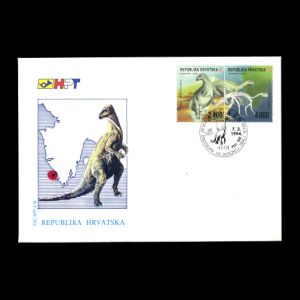 |
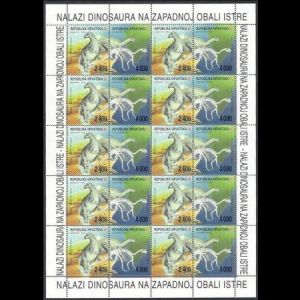 |
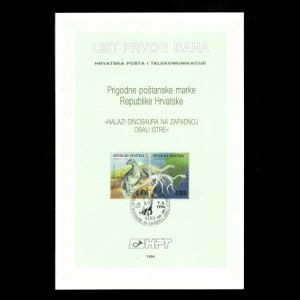 |
| Circulated FDC | Examples of Circulated Covers | |
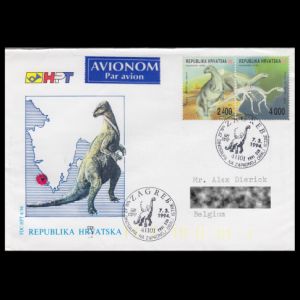 |
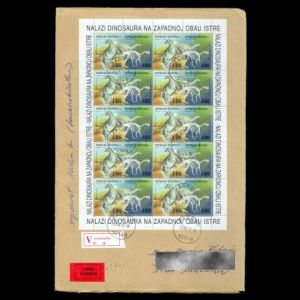 |
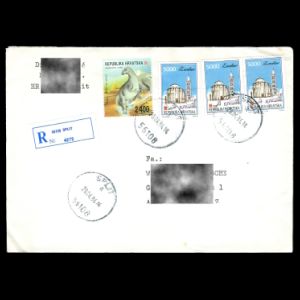 |
| First-Day-of-Issue Postmark | Additional Postmarks "Dinosaurs from Western Istria" | |
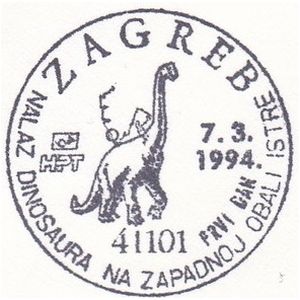 |
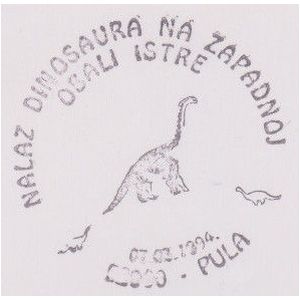 |
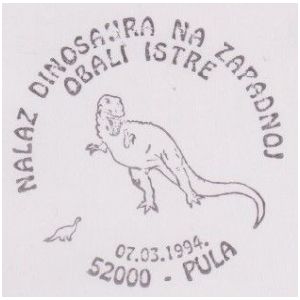 |
| Pula is the largest city in Istria County, Croatia, and the seventh-largest city in the country, situated at the southern tip of the Istrian peninsula. | ||

|
References
- Technical details and short description of the stamps:
Croatian Post (English text is short, Croatian text is more detailed), Colnect, Reverse side of a Souvenir Sheet - The footprints:
myistria.com, premantura.net.
Acknowledgements
Many thanks to Dr. Peter Voice, PhD Department of Geological and Environmental Sciences, Western Michigan University, USA, for his help in finding information and for review of a draft of this article.| <prev | back to index | next> |
